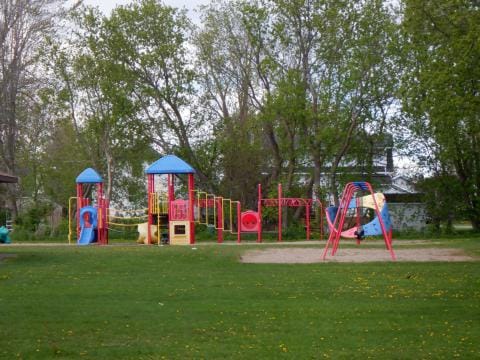Finch is a quintessential town on the Southern tip of North Stormont Township. Neighbours make time to stop and talk on their way to the store, bank or restaurant. The quiet charm of Finch is intermittently disrupted by the sounds of hard working farmers, business owners and children having fun. The Finch Arena is a popular place for skating and hockey and still offers public skating to guests each week until March for an incredible $1.25 a person. The second floor of the Arena is a beautifully renovated facility perfect for community events, family parties and business meetings.

Other services in Finch include:
- Arena (newly renovated and ready to host your next event)
- Community Centre
- Fire Station 1 - Finch
- Finch Branch | SDG Library
- Public Park with playground
- Baseball diamond with canteen
- Baseball program for all ages and skill levels
- South Nation Conservation Office
- United, Catholic and Presbyterian Churches
- Community events like the broomball league for youth and adults, annual events such as the Halloween Party, Santa Clause Parade of Lights and Winter Carnival
History
In 1802 eight families – four Camerons and four MacMillans – came out from Scotland with a charter group organized by Allen (Glen Payne) MacMillan, and in 1803 made their way on foot to this area and took up land.
Early accounts give us an idea of the hardships they endured and show that the first name given to this small hamlet in the woods was Gray’s Corners, since a man by the name of Nelson Gray ran a store on the corner of Front and Victoria Streets.
The name South Finch is believed to have been given to the area later when a school master by the name of Joseph Finch (related by marriage to Viscount Stormont) lived here, and then it was shortened to Finch when the railway went through in 1885.
The hamlet grew as a temperance hotel, cheese factory, store, a blacksmith shop, a large sash & door factory and other buildings took up residence.
Along the Payne River to the east of the village was an area known as Brooklyn, and the bridge, of course, was named the Brooklyn Bridge.
The religious needs of the community have always been well tended. The Orange Hall, also called the Merkley Hall, was used by the Methodists for services before a church was built.
In 1891 the Methodists moved the McMonagle Church from the 5th Concession of Finch Township into the hamlet to the present sight of Chalmers United Church.
St. Luke’s Presbyterian Church was moved from Lot 19, Concession 2, Finch Township, into Gray’s Corners in 1892. St. Bernards’ Catholic Church was built at its present location on Front St. in 1889.
The first school, a log building, was built around 1850 west of the village. Around 1900 a frame structure known as the Pink School was built on the site of what later became North Stormont District High School (which was closed in 1974 when Tagwi Secondary School was built), and then became the Furniture Loft. In 1959 a new four room elementary school was built on Church St., and was utilized until 1989, when it was closed and the children sent to Berwick.
In September 1961, St. Bernard’s Separate School, a three room structure which has since been expanded, was opened south of the village.
By now South Finch, became the focal point for transportation when the single line of the CPR was built in 1885. In 1897 the Ottawa and New York Rail Line was put through and later became known as the New York Central.
The double track of the CPR was laid in 1907 and this necessitated the construction of a new station at the intersection of the two lines.
This became popularly known as “The Diamond”.
Adjacent to the tracks was the two-storied Control Tower where all the telegraph equipment was installed as well as the many levers which controlled the semaphores for the nearly 50 trains a day that passed through the Diamond.
In the early 1900s there were three trains a day each way on the CPR (the “Midnight” going west, and the early morning train going east had to be flagged down – a neat trick!) and two north and two south on the NYC. This was during the exodus of families to New/Northern Ontario to strike it rich in the mining areas or “Out West” to make their fortunes.
In 1907 a ticket to the west cost $12.00 and some Real Estate companies offered free one-way trips.
The trains transported loads of horses as well as furniture and belongings of families.
Coal and feed dealers in the area shipped their products via train. During the 1930s to 50s, up to 50 cans of milk a day were loaded each morning to be shipped to Montreal. Part of the station was leased in the early 40s to the Stormont Poultry and Egg Producers and eggs were graded here and shipped to Montreal.
Then in 1946 Canada Packers built a fine new Poultry & Egg Processing plant (later the site of D&F Foam) and for several years it was a hub of activity for Finch, increasing the volume of shipping by rail and truck and providing employment for many.
The NYC ceased operation in 1957 and the rails were removed. Slowly but surely the passenger and mail service ground to a halt and the CPR station was closed in 1969.
Finch has had over the years many fires, but two of the most disastrous occurred on May 16th and 17th, 1907. A condensed account from the Chesterville Record follows:
On Monday afternoon a bonfire exceeded its bounds and ignited coal oil barrels behind A.F. Dey’s store. Within a short period of time the whole of the east side of Main St. north to Church St. and east to the then Methodist Church (now Chalmers United) had been destroyed.
The block in which the Dey’s store was located was owned by F.D. McNaughton and contained the Merchants’ Bank, the Public Library, the armory with the equipment of No. 4 Company of the 59th Regiment and a complete issue of 42 uniforms and rifles, and the local headquarters of the Orange Lodge, all of which were destroyed.
To the east the blacksmith’s shop of F.A. Dingwall was consumed, as well as the old St. Luke’s Church, which had been moved back and was used for storage. Meanwhile volunteers had hastily removed the organ from the Methodist Church before it too was demolished.
The residents barely had time to take stock of the situation when another fire broke out in the storage area at the rear of Lowe’s Store (later the Red & White) and quickly spread to the east where it consumed Arbuthnot’s Drug Store, and Thos. Hamilton’s Store which housed the telephone exchange and telegraph office.
The Gormley Hotel to the east was saved only through the heroic efforts of the volunteer bucket brigade, in particular, men from Chesterville under the leadership of F. McCloskey, J.T. Kearns and M.J. McEvoy.
The side next to the fire was covered with quilts and blankets which were kept wet. The east side of Hamilton’s Store was iron-clad, so it burned from the inside. Props were placed against the walls so that it collapsed inward. All these exceptional efforts to save the hotel elicited many nasty remarks in the days following the fire, to the effect that the proprietor had supplied free refreshments(?) to make sure of enthusiastic help from the bucket brigade.
The fire spread westward across the street to Dan Nephew’s Store, G.J. MacDonald’s tailor shop (later Dr. MacLeod’s) and on to the Presbyterian Church; then northwards to the Barringer house, Munroe house, and Munroe block containing the clerk’s office, J. McCuaig’s carriage shop and several small barns and carriage sheds.
Around 4:30 a.m. the valiant firefighters who had rallied from every neighbouring village and hamlet had quelled the blaze just short of J.M. Campbell’s residence on the west side of Main St. and D.G. MacMillan’s on the east side. On the south of Front St., A.
McDougall’s General Store, which housed the Post Office, caught fire several times, but was saved.
The total two-day loss was nearly $100,000. From the March 26, 1809 issue of the Record, we read: “Phil Low, son of J.H. Low, confessed on Wednesday to Reeve McNaughton, guilty to two charges of arson in connection with the fire in 1907” (no record of punishment).
Again in 1919, fire destroyed a major portion of the east side of Main St. from Church St. north. The bucket brigade sure got lots of practice in those days.
Over the years many changes have come about in the village:
The Brownlee Funeral Home was established in 1905 by W.J. Brownlee, followed in time by his son W.G. (Bill) and then his son, Barry.
A landmark often referred to in social columns of the 1900s was the Massey Hall (or sometimes O’Neill’s, Oliver Wert’s, I.O.O.F., depending on who owned it!). The bottom part was first used as a sales room by the Massey-Harris Machine Co., hence the name. An inside stairway led to the upper floor where many fancy balls, concerts and medicine shows were held.
It was located on John St., just west of Main. The Gormley House, which stood on Front St., was a magnificent building, with three stories, 50 rooms and balconies above and below.
Many mentions were made in local papers of distinguished people staying there. One of the many doctors Finch has known was Dr. John G. MacLeod, who came to Finch in 1920 and served for over 50 years. His home and office is still located on Main St., previously a bed & breakfast, now a craft and gift store operated by Khrista Thompson.
The original Finch Arena, built by the Finch Arena Co. – a group of civic minded local residents – was one of the best rinks in the area and the scene of some famous hockey games featuring the Inkerman Rockets, Stormont Blue Devils, Finch Wolverines and many Cornwall teams.
Special trains were run from Cornwall for these games.
In the summer a wooden floor was laid down over the ground surface of the arena and Friday night dances in Finch were a must in the social life of area youths.
In 1905 an application was made by a group of public minded citizens to the Legislative Assembly to have the hamlet of Finch incorporated as a village with its own government body. Permission was granted in March, 1906. The first Reeve was Geo. L. MacLean, the Clerk was James Simpson, and Treasurer was Arthur Chester. Finch Village had ten Reeves – six of whom had the distinction of becoming Wardens of the United Counties of Stormont, Dundas & Glengarry – up until its amalgamation in January 1998 as part of North Stormont Township. The longest-serving was Lynden S. Hough, Reeve from 1963-1997.
We’ve written much, and of necessity omitted much. There’s a lot of history in 135 years. We’ve enjoyed good times and not so good. We had one murder in 1922, a bank robbery in 1970 and the usual number of personal tragedies. There have been two train wrecks, but for the most part, life in Finch goes on in a relatively calm manner. We have no aspirations to make it to the “big time”; we enjoy being just what we are – a small village with a community spirit second to none.
Excerpts from “Finch Village 135th Anniversary Celebrations
June 29th – July 3rd, 1989″
By Mrs. Marion Hough
Services
4 John Street
Finch, ON
K0C 1K0
Phone: (613) 984-2024Deputy Chief: Steve Tait
11 John Street
Finch, ON
K0C 1K0For emergencies call 911
For non-emergency information, call 613-984-2821 (x257)SDG Police Services
Main Detachment
4 Mille Roches Road
Long Sault, ON
K0C 1P0Phone (613) 534-2223
Fax (613) 534 – 2486Emergency: 911

